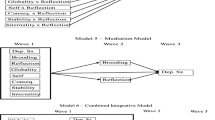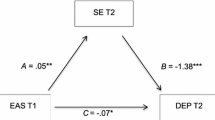Abstract
This prospective study tested the diathesis-stress and symptom components of the integration of the hopelessness and self-esteem theories of depression in a sample of third- and seventh-grade children. The procedure involved an initial assessment of depressive symptoms, self-esteem, and depressogenic inferential styles about causes, consequences, and the self. The procedure also involved a follow-up assessment, 6 weeks later, in which depressive symptoms and the occurrence of negative events were assessed. In line with the integrative theory, depressogenic inferential styles interacted with negative events to predict increases in hopelessness but not nonhopelessness depression symptoms in boys with low but not high self-esteem. At the same time, contrary to the integrative theory, depressogenic inferential styles interacted with negative events to predict increases in hopelessness but not nonhopelessness depression symptoms in girls with high but not low self-esteem.
Similar content being viewed by others
References
Abela, J. R. Z. (2001). The hopelessness theory of depression: A test of the diathesis-stress and causal mediation components in third and seventh grade children. Journal of Abnormal Child Psychology, 29, 241-254.
Abela, J. R. Z. (2002). Depressive mood reactions to failure in the achievement domain: A test of the integration of the hopelessness and self-esteem theories of depression. Cognitive Therapy and Research, 26, 531-552.
Abela, J. R. Z., & D'Alessandro, D. U. (2001). An examination of the symptom component of the hopelessness theory of depression in a sample of schoolchildren. Journal of Cognitive Psychotherapy: An International Quarterly, 15, 33-47.
Abela, J. R. Z., & Sarin, S. (2002). Cognitive vulnerability to hopelessness depression: A chain is only as strong as its weakest link. Cognitive Therapy and Research, 26, 811-829.
Abramson, L. Y., Metalsky, G. I., & Alloy, L. B. (1989). Hopelessness depression: A theory based subtype of depression. Psychological Review, 96, 358-372.
Allgood-Merten, B., Lewinsohn, P. M., & Hops, H. (1990). Sex differences and adolescent depression. Journal of Abnormal Psychology, 99, 55-63.
Alloy, L. B., & Clements, C. M. (1998). Hopelessness theory of depression: Tests of the symptom component. Cognitive Therapy and Research, 22, 303-335.
American Psychiatric Association. (1994). Diagnostic and statistical manual of mental disorders(4th ed.). Washington, DC: Author.
Beck, A. T. (1967). Depression: Clinical, experimental, and theoretical aspects. New York: Harper & Row.
Brown, G. W., & Harris, T. O. (1978). Social origins of depression: A study of psychiatric disorder in women. New York: Free Press.
Cohen, J., & Cohen, P. (1983). Applied multiple regression/correlation analysis for the behavioural sciences(2nd ed.). Hillsdale, NJ: Erlbaum.
Conley, C. S., Haines, B. A., Hilt, L. M., & Metalksy, G. I. (2001). The Children's Attributional Style Interview: Developmental tests of cognitive diathesis-stress theories of depression. Journal of Abnormal Child Psychology, 29, 445-463.
Coyne, J. C. (1976). Toward an interaction description of depression. Psychiatry, 39, 28-40.
Dixon, J. F., & Ahrens, A. H. (1992). Stress and attributional styles as predictors of self-reported depression in children. Cognitive Therapy and Research, 16, 623-634.
Hammen, C. L., Adrian, C., & Hiroto, D. (1988). A longitudinal test of the attributional vulnerability model of depression in children at risk for depression. British Journal of Clinical Psychology, 27, 37-46.
Hankin, B. L., & Abramson, L. Y., & Siler, M. (2001). A prospective test of the hopelessness theory of depression in adolescence. Cognitive Therapy and Research, 25, 607-632
Hilsman, R., & Garber, J. (1995). A test of the cognitive diathesis-stress model of depression in children: Academic stressors, attributional style, perceived competence, and control. Journal of Personality and Social Psychology, 69, 370-380.
Joiner, T. E., Steer, R. A., Abramson, L. Y., Alloy, L. B., Metalsky, G. I., & Schmidt, N. B. (2001). Hopelessness depression as a distinet dimension of depressive symptoms among clinical and non-clinical samples. Behaviour Research and Therapy, 39, 523-536.
Kanner, A. D., Feldman, S. S., Weinberger, D. A., & Ford, M. E. (1987). Uplifts, hassles, and adaptational outcomes in early adolescents. Journal of Early Adolescence, 7, 371-394.
Klerman, G. L., Lavori, P. W., Rice, J., Reich, T., Endicott, J., Andreason, N. C., et al. (1985). Birth-cohort trends in rates of major depressive disorder among relatives of patients with affective disorder. Archives of General Psychiatry, 42, 689-695.
Kovacs, M. (1981). Rating scales to assess depression in school children. Acta Paedopsychiatrica, 46, 305-315.
Metalsky, G. I., & Joiner, T. E., Jr. (1997). The Hopelessness Depression Symptom Questionnaire. Cognitive Therapy and Research, 21, 359-384.
Metalsky, G. I., Joiner, T. E., Jr., Hardin, T. S., & Abramson, L. Y. (1993). Depressive reactions to failure in a naturalistic setting: A test of the hopelessness and self-esteem theories of depression. Journal of Abnormal Psychology, 102, 101-109.
Nolen-Hoeksema, S., Girgus, J. S., & Seligman, M. E. P. (1992). Predictors and consequences of childhood depressive symptoms: A five-year longitudinal study. Journal of Abnormal Psychology, 101, 405-422.
Panak, W. F., & Garber, J. (1992). Role of aggression, rejection, and attributions in the prediction of depression in children. Development and Psychopathology, 4(1), 145-165.
Robinson, N. S., Garber, J., & Hilsman, R. (1995). Cognitions and stress: Direct and moderating effects on depressive versus externalizing symptoms during the junior high school transition. Journal of Abnormal Psychology, 104, 453-463.
Rosenberg, M. (1965). Society and the adolescent self-image. Princeton, NJ: Princeton University Press.
Seligman, M. E. P., Peterson, C., Kaslow, N. J., Tenenbaum, R. L., Alloy, L. B., & Abramson, L. Y. (1984). Attributional style and depressive symptoms among children. Journal of Abnormal Psychology, 93, 235-241.
Silber, E., & Tippet, J. (1965). Self-esteem: Clinical assessment and measurement validation. Psychological Reports, 16, 1017-1071.
Southall, D., & Roberts, J. E. (2002). Attributional style and self-esteem in vulnerability to adolescent depressive symptoms following life stressors: A 14-week prospective study. Cognitive Therapy and Research, 26, 563-579.
Turner, J. E., & Cole, D. A. (1994). Developmental differences in cognitive diatheses for child depression. Journal of Abnormal Child Psychology, 22, 15-32.
Author information
Authors and Affiliations
Corresponding author
Rights and permissions
About this article
Cite this article
Abela, J.R.Z., Payne, A.V.L. A Test of the Integration of the Hopelessness and Self-Esteem Theories of Depression in Schoolchildren. Cognitive Therapy and Research 27, 519–535 (2003). https://doi.org/10.1023/A:1026303020478
Issue Date:
DOI: https://doi.org/10.1023/A:1026303020478




